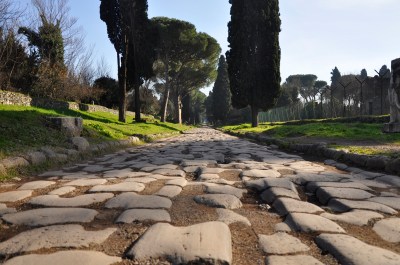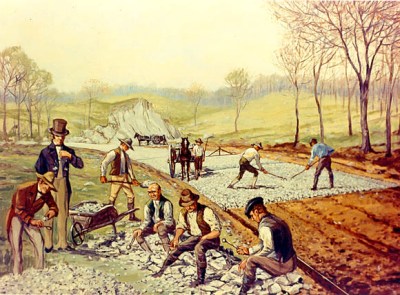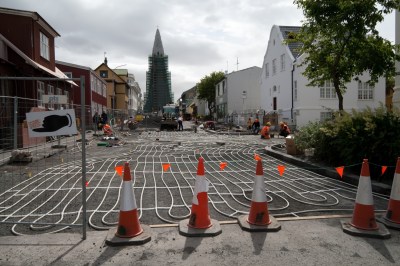A lot of us take roads for granted, at least until they are icy or torn up by construction. The concept of creating fixed paths seems to be in our firmware. Finding the shortest distance to food or water and marking a trail to it from home base has always been its own reward.
Roads have come a long way from the simple paths beaten by man and beast. But the basic configuration of paved roads hasn’t changed all that much since the Roman empire. Whatever they’re made of, they need to be able to drain water and support heavy loads.
New issues arose as modes of transportation shifted in favor of the automobile. Road surfaces needed to provide friction against tires. But how did we get from the stone-paved roads of Rome to the asphalt and concrete roads of today?
All Roads Lead to Rome
There is evidence that the Mesopotamians were laying stone roads as early as 4000BC. The Bronze Age greatly advanced tool making, which made it much easier to cut stone. Around 2400BC, the Egyptians were building roads in order to transport the huge blocks of limestone that make up the pyramids. It was clear from the beginning that roads must be able to support heavy loads without buckling or shifting. Long-lasting, quality roads would require ingenuity and craftsmanship in equal parts.

The oldest existing paved road was built in Crete around 2000BC. It’s about twelve feet wide and is made of sandstone mixed with a clay-gypsum binding material. Two rows of basalt slabs run down the middle of it. The road slopes downward from the center on both sides to promote drainage, and some sections even have gutters.
The Romans drastically changed the course of transportation engineering because they built connected systems of sturdy roads. This idea was crucial to the spread of their control because they were able to move armies around and collect taxes.
The vast network of roads centered on the empire’s capital and drastically increased the capacity for trade with neighboring countries such as Greece. Over the course of their rule, the Romans laid some 50,000 miles of hard-surfaced roadways. These roads fostered communication throughout the empire and helped to create an extensive culture that informed much of Western civilization.
Regular Roman roadways were all created in roughly the same way. They averaged around fifteen feet wide and four feet thick, and were built using several layers of supporting material. Every new road project began just as they do today—with earthwork engineering. Workers dug a deep, level trench for the roadway with a ditch along each side for drainage. They would cover the trench with a layer of sand or small broken stones. These would be spread out evenly and then tamped down with rollers.

On top of this was a layer of large stones set in a mortar made of lime. Shards of bricks and pottery were often distributed on top of this stone layer and set with clay-based cement. On the surface was a course of large volcanic rock cobbles stones arranged as tightly as possible.
Important military roads radiating from Rome were wider and more elaborately built. The most famous one, the Appian Way, ran between Rome and the port of Brindisi and spanned about 350 miles. The Appian Way was broad enough that two carriages could pass each other with ease. Roads like this one were paved with thick blocks of silex arranged closely together, the gaps between them filled with gravel and sand.
Paving the Way for Modern Roads
Roads were built the Roman way for centuries. The solid, well-draining model provided traction for early wheeled vehicles and the horses that pulled them. Roads began to change in 18th century France when a transportation engineer named Pierre-Marie-Jérôme Trésaguet suggested that deep foundation courses of stone and gravel were unnecessary. He believed that solid subsoil would suffice to support the surface material.

Trésaguet proposed that roads be built with a course of thick stones laid on their edges at the bottom of a crowned trench. These vertical foundation stones would be pounded together to ensure a tight fit. A two-inch layer of broken stones sat atop the large foundation stones, followed by an inch-thick layer of gravel.
Around the same time, a Scottish stonemason named Thomas Telford began building roads similar to Trésaguet’s, though he put special emphasis on supporting a lot of weight. Telford’s foundations also used thick stones placed on edge, but they were not as tall as Trésaguet’s. These stones were carefully laid by hand. They varied in height, sloping downward from the middle toward the edges.
No More Than a Mouthful
The biggest paradigm shift since the Roman systems of roads began with John Loudon McAdam, another Scottish road builder. His legacy lives on in the “macadam” roads of today.
McAdam looked for cheaper methods that required less labor. He believed that the thick stone foundations of Roman engineering were completely unnecessary, and was certain that the issues of load support and drainage could be addressed with a bed of sharp-edged broken stones packed together.

McAdam insisted that these stones not exceed one inch in any dimension. His own rule of thumb was that a properly-sized stone would fit in the road worker’s mouth. He supplied roadside stone inspectors with one-inch rings so that they could keep tabs on size as workers broke up stones with small hammers.
McAdam built his roads as level as possible. The average rise from the edges to the center was only three inches. He didn’t believe in rolling the stones to tamp them down. Instead, he let traffic and time do the work. This made his road-building methods cheaper and therefore more attractive to government officials, although the settling period was hard on horses’ hooves.
Warming Up to Other Methods
McAdam’s roads were revolutionary. But the rise of the automobile forced certain changes in road construction. As tires sucked at the road surface, they kicked up a lot of dust and dismantled the road. An attempt to solve this problem was made by spraying the surface with a mixture of coal tar and ironworks slag. This material was patented under the name tarmac. Beginning in the 1920s, the stone aggregate and binding material were mixed together in advance. Coal tar was replaced by bitumen, as substance that occurs naturally and as a by-product of distilling petroleum.

Rubberized asphalt and snowmelt systems are among the most modern advances. Rubberized asphalt contains finely ground crumb rubber from old tires. This significantly reduces traffic noise and the number of tires in landfills, but the material can only be applied to roads within a certain temperature range.
Snowmelt systems use either electrical elements to heat the surface or a hydronic tube system to deliver a water and antifreeze mixture. These systems can be activated manually or start automatically when well-placed sensors detect moisture and freezing temperatures.
Sources
Benson, Fred and Maxwell Gordon Lay. “roads and highways.” Encyclopaedia Britannica. Britannica Academic. Encyclopædia Britannica Inc., 2015. Web. 8 Nov. 2015.
Holley, I.B. The Highway Revolution, 1895-1925: How the United States Got Out of the Mud. Durham: Carolina Academic Press, 2008. Book.
Kaszynski, William. The American Highway. Jefferson: McFarland & Company, 2000. Book.
Staccioli, Romolo Augusto. The Roads of the Romans. Los Angeles: Getty Publications, 2003. Book.
















Modern road systems are very interesting, anyone driving past modern highway construction can’t help but wonder at the mechanics behind those huge concrete machines, the piles of steel rod, the depth and makeup of the road bed, and the newer techniques of laying asphalt below the concrete. Bridges and overpasses being supported by steel pilings that are driven into the ground all the way to bedrock by huge pile drivers. The recycling of the smashed remains of the previous road into the new foundations and ramps. The seemingly impossibly complex planning and positioning of each element such that all the roads flow smoothly into each other once complete.
No concrete roads here in New England. Well, a few, but they’re maintenance headaches. Concrete’s porous and rigid, two qualities that don’t mesh well with freezing. It’s all asphalt up here.
Amazingly I’m in Wisconsin, and they still use quite a bit of concrete for the freeways, at least through the cities. Almost every other long stretch of road is asphalt. Actually some of the road surfaces on the new fly-over interchanges are some type of epoxy bound aggregate. Not sure how that works.
I lived in Massachusetts for a number of years and due to the amounts of salt used on the roads, I learned this joke:
Q.) What do you call a five year old car in Massachusetts?
A.) An Antique.
We have many concrete expressways in West Michigan, e.g. M-6, I-196, I-96, and US-131, and they seem to have held up better than the asphalt ones of decades past. In fact, part of a fairly busy highway near me, Chicago Drive, was made with concrete around 1933, IIRC, and only had to be replaced within the past five years. The stuff is extremely durable, as long as it’s made, installed, and maintained properly.
That last point is probably underestimated by most county road commissions. I point to Old M-151/US-223/St. Anthony/Samaria/Luna Pier Road in Monroe County (other side of the state) as a poignant example of how NOT to maintain a concrete highway. After many years of trying to “fix it” with asphalt (yes, they’d actually have someone with a shovel walk behind, scoop hot asphalt from a truck bed, and throw it down into cracks!), it seems they gave up, and it has been replaced entirely with asphalt. Whether it’s due to simply not having the budget, or possibly expertise, to maintain a concrete highway, I can’t say.
As for freezing and snow? There’s that little snow machine to the west called Lake Michigan. ;)
A follow-up question: do your concrete highways have ‘grooves’ in them, running the same direction as traffic?
Agree that it is fascinating to watch a new interchange come into being… from the first pile of dirt that is moved to the first time I can take the new on-ramp / off-ramp… it all has to be planned and performed “perfectly” to ensure the curves and angles and heights line up… fun to see it all happen!
Just a heads up: the image that’s attributed to Walt Stevenson is actually an original illustrated from David Macaulay’s ‘City’, a truly excellent book about the founding and development of an archetypical Roman city. This is the same author who also write/drew ‘The Way Things Work’ and a number of other excellent books about the way various things were built historically.
Yes, that image looked familiar. Macaulay’s books were some of my favourites as a child and still are, my seven year old son likes them too. Highly recommended.
Thank you! This has been fixed.
Building road where there is no winter is cheaper but where there is winter freezing, road bed need to be a least 1 meter deep to drain water deep enough to avoid it to freeze. Water freezing and melting cycles do a lot of damage to roads.
“. . .but where there is winter freezing, [the] road bed need[s] to be a[t] least 1 meter deep to drain water enough to avoid [damage].”
That’s not necessarily true at all. I’m finishing the design for a road widening in which areas of the road foundation and the wearing course total 1/3 of that which you think is the minimum. Further, this road has been in use for ~70 years with only minor problems in a single 100 ft section. (Amusingly, this is an area near a stream crossing, and the road bed is thickest here.)
The Dalton Highway, in the area of the Sagavanirktok River flooded this summer and the road was raised from 0.6M above the ground, to 3M above ground. The only reason for this was to prevent erosion of the road surface. Much of the length of the Elliot Highway is paved, and also has a shallow foundation, depending on conditions at any particular location.
That said, we also impose severe weight restrictions in the spring when drainage is necessarily poor. On some roads heavy trucks are limited to as little as 50% of their rated axle loads, or even entirely prohibited. We’ve also had our share of problems with ice (seasonal cycling, as well as areas of warm permafrost) and some sections of highway have ridiculous maintenance costs.
1 meter deep to avoid freezing only works below a certain latitude. Frost goes much deeper the further north you go, and once there is traffic on a cold road it pounds the frost down even deeper.
I used to work in the Oil field. While is isn’t typical on year I seen the front get to seven feet down. No doubt some comprimise has to be made on road construction.
Thanks,Kristina, great post. And here I was thinking I’m the only road geek here.
Thanks Kristina, you’re quite the roads scholar.
Lol :)
Interesting that, after 6,000 years of building roads, we’re still dealing with the need to constantly repair potholes, cracks, and other road damage… must be cheaper to do that than put in the R&D to develop better materials and methods (and I don’t mean Solar Frickin’ Roadways!)
Yup…Roman roads last millenia, our street heaves after 3 years…
(Nice article. I did a project in public schools on road construction, so this is memory lane for me)
One development that has much improved the resistance of asphalt to cracking and potholes is a special fabric layer between two layers of asphalt. Curious thing is I haven’t seen it being used lately in road rebuilding, just a finish layer of asphalt atop the base layer.
There’s a process of doing in-place asphalt recycling. A train of machines chews up the old asphalt, smooths and packs the base, adds a small amount of fresh bitumen while heating up the old asphalt then lays it back down to be rolled.
Do I miss the point or it has nothing to do with hacking?
Yes you missed the point
I No you know how to hack a good road if your ever need it. To build mydrive ~1,000 feet at my place I fixed I purchase and fixed up a 1948 REO Speedwagon with a 13 foot bed with hydraulic hoist. The truck was bit of street Rod as others kept it working over the years A Buick nail head V 8 mated to a ford transmission using an aluminum adaptaplate. Damn building that drive and doing other hauling was fun. Lived up to it’s name too, would go 70 MPH if you where brave enough to trust the old tires. Alas the truck is no more.
What, REO Speedwagon is a vehicle?
Yes, made by Ransom Eli Olds. The Oldsmobile guy.
The 2nd invention after the wheel was the road
:) That’s a good one ! Cheers !
Now, make an article about road repairs. For example I can identify German and UK repairs by the different colour of the asphalt. On the other hand, I can identify Greek road repairs, by the difference in colour and by the way the car bounces over them…
That’s a great idea my friend ! Very useful. I hope it will be made into something real.